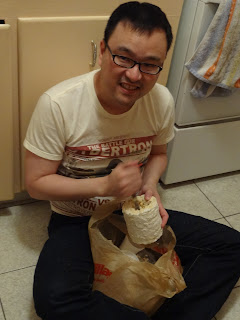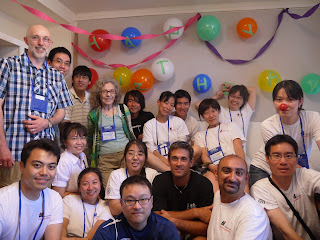Events in Ottawa have always been convenient. With several places to stay and the benefit of reuniting with family and friends, we can't really complain about the 5 hour drive from Toronto. The city is clean and has a small town feel that's friendly and inviting. We've had some pretty good Canadian cuisine in past visits, but the continued lack of good Asian restaurants is rather disappointing.
The Japanese community in Ottawa is quite active though, with the JET Alumni Association hosting an annual
summer festival, presenting food, culture, and art. The martial arts are seeing positive signs of growth, and along with the Language and Ikebana classes found in the core of the city, are really helping to promote Japanese culture. Lead by the Takahashi and Tateyama dojos, students looking to get into the world of Budo can be guaranteed an experienced base of instruction.
This year, organizers of the Ottawa Seminar had graciously moved their spot back a month to allow for the
Peterborough Koryu Seminar, and modified the format by combining Kendo and Iaido. This happened to be a perfect fit for the visiting Sensei, who between them, have over 50 years of experience in both sword arts:
- Goyo Ohmi-Sensei (Iaido Renshi 7 Dan, Kendo Renshi 6 Dan)
- Stephen Cruise-Sensei (Iaido Renshi 7 Dan, Kendo 5 Dan)
Students were able to attend both sessions, with introductory details provided for those who want to experiment. It was encouraging to see almost 10 individuals trying out Iaido for the first time. As usual, the team of David Green-Sensei, Chris Jarvie, and Stan Vardomskiy, made it simple to register and gave us all a warm welcome to our nation's capital.
 |
| Tateyama Kendo/Iaido/Jodo Club |
The weekend schedule was split evenly each day, with a morning Kendo session, followed by Iaido in the afternoon on Saturday; and the reverse on Sunday
Saturday, November 3 @
Takahashi Dojo
Located just west of China town, the dojo sits on the corner of a cozy residential neighbourhood surrounded by a few local eateries. With the Iaido session starting at 3pm, Hanna and I were able to have breakfast with her parents before meeting up with a couple of friends for lunch at the "
Art is in Bakery". Small restaurants like this one, found in an industrial area not far from the dojo, are an excellent example of hidden gems throughout this city. Based out of a "literal" warehouse space, the Canadian-born and raised chef had perfected his trade in New York City, France, and Switzerland, before returning to serve amazing sandwiches, flatbreads, and a treasure trove of baked goods. Having thoroughly gorged ourselves on sandwiches, tarts, and coffee, followed by a quick visit to another local shop,
Isobel's Cupcake for second dessert, we definitely had enough energy for an afternoon of intense Iaido practice.
We arrived a little early, just as the first session was winding down and the Sensei's were going off for some refreshments. Our stomachs were pretty full already, and not wanting to risk falling asleep by sitting around, we proceeded downstairs to the unoccupied tatami room for some pre-seminar keiko. The room was big enough for us to share with our good friend from Nova Scotia, Karen, but we definitely had to watch the pipes running across the ceiling. Other participants started trickling in over the next half hour, and it wasn't long before the Iaido session was ready to begin.
While Ohmi- and Cruise-Sensei got ready, Green-Sensei lead us through a few exercises that we recently learned from Kishimoto-Sensei in Guelph earlier this year. With our muscles warmed up and a good sweat keeping our joints lubricated, Green-Sensei took the first time Iaidoka upstairs while Cruise-Sensei took the Kyus, and Ohmi-Sensei lead the those from 1 Dan to 4 Dan. Edward Chart (5 Dan) assisted him on the side.
Due to space limitations, we were split into three groups and took turns going through the ZNKR Seitei set with Ohmi-Sensei providing rank suitable pointers:
A) 1 Dan - Big technique, Clear movements
B) 2 and 3 Dan - Show understanding and feeling, Seme
C) 4 Dan - Show experience, Kihaku and Kigurai
The first hour went by very quickly as we transitioned to demonstrations from anyone who wanted to "volunteer", with some slight nudging from Ohmi-Sensei: =P
Demo 1 - Ed Chart performing 1 koryu + shitei waza. Once again, we were blown away by his Iaido. An equally dynamic and engaging performance, approaching levels we've rarely seen, even in Japan.
Demo 2 - Seminar organizers: Chris (4 Dan), Stan (2 Dan - challenging 3 Dan next month)
Demo 3 - John (Treasurer of the Canadian Kendo Federation), Karen (visiting from Nova Scotia)
Demo 4 - Phil (longest student of Green-Sensei from Ottawa), Andre (visiting from New Brunswick)
The seminar wound down around 5:30pm. We all bowed out and looked forward to more Iai the following morning.
Sunday, November 4 @
Carleton University
It wouldn't be the annual Ottawa Iaido seminar if it didn't start out with a brisk, cold morning. Frost (some of the first of the season) was seen scattered around and blown about by a light breeze. It was a short drive from Hanna's parent's house to Carleton University and we arrived just as a few others were walking in.
The building was very pleasantly heated, unlike last year's community centre, with the space split between a wood floor-room lined with mirrors (9:30-11) and a padded-floor room with windows along one side (11-12:30). Like the day before, Green-Sensei gave instruction to those new to Iaido, while Cruise-Sensei lead us through warmups followed by Seitei 1-10 with assistance from Ed Chart.
Today's teaching was on following proper form, posture, and doing it by the book, as past tendencies and lack of focus had lead to bad habits. It was good to be reminded of the fundamental requirements that are laid out by the All Japan Kendo Federation, and especially beneficial with a grading coming up in less than a months time.
We had a short break at 11 to move to the next room, and Ohmi-Sensei took over for the final portion of the seminar. The lesson:
Mitori-keiko (training/learning through observation). With everyone along one side of the room, Ohmi-sensei positioned himself in the center and proceeded to go through Seitei 1-10, performing each kata twice; first facing forward, and then 90 degrees to the side so we can watch in profile. After each technique, I tried my best to take what I could from his demonstration and inject it into mine. We took turns in the center, rotating after each kata. In an attempt to improve the overall quality of this demonstration, I tried to match my entrance and exit timing to Ohmi-Sensei's, maintaining the symmetry that is seen in Kyudo demonstrations. It was a fun practice. =)
The session wrapped up with a demonstration from Cruise-Sensei doing two koryu + five seitei, then Hayanuki. We don't often get to see MSR Koryu, so it was nice to have the opportunity to observe the difference in movement, scenario, and emphasis. The longer sword and sharp noto made for quite an impressive display. As the Kendo students began to arrive after lunch, we bade our farewells and prepared ourselves for another five hour drive back to Toronto.























































